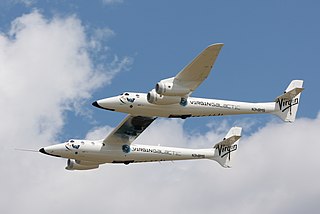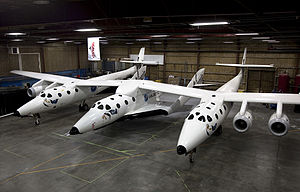
SpaceShipOne is an experimental air-launched rocket-powered aircraft with sub-orbital spaceflight capability at speeds of up to 3,000 ft/s (2,000 mph) / 910 m/s (3,300 km/h) using a hybrid rocket motor. The design features a unique "feathering" atmospheric reentry system where the rear half of the wing and the twin tail booms folds 70 degrees upward along a hinge running the length of the wing; this increases drag while retaining stability. SpaceShipOne completed the first crewed private spaceflight in 2004. That same year, it won the US$10 million Ansari X Prize and was immediately retired from active service. Its mother ship was named "White Knight". Both craft were developed and flown by Mojave Aerospace Ventures, which was a joint venture between Paul Allen and Scaled Composites, Burt Rutan's aviation company. Allen provided the funding of approximately US$25 million.

Virgin Galactic Holdings, Inc. is a British-American spaceflight company founded by Richard Branson and the Virgin Group conglomerate which retains an 11.9% stake through Virgin Investments Limited. It is headquartered in California, and operates from New Mexico. The company develops commercial spacecraft and provides suborbital spaceflights to space tourists. Virgin Galactic's suborbital spacecraft are air launched from beneath a carrier airplane known as White Knight Two. Virgin Galactic's maiden spaceflight occurred in 2018 with its VSS Unity spaceship. Branson had originally hoped to see a maiden spaceflight by 2010, but the date was repeatedly delayed, primarily due to the October 2014 crash of VSS Enterprise.
Mojave Aerospace Ventures (MAV) is a company founded by Paul Allen and Burt Rutan to handle the commercial spinoffs from the Tier One project. It owns the intellectual property arising from Tier One, and it is in turn owned by Allen and Rutan's Scaled Composites. In 2004, it signed a deal with Virgin Galactic to develop the Virgin SpaceShip, a suborbital spacecraft, for space tourism. Virgin Group and Scaled Composites have subsequently formed a joint venture, The Spaceship Company, to manufacture the spacecraft.

Air launching is the practice of releasing a rocket, missile, parasite aircraft or other aircraft payload from a mother ship or launch aircraft. The payload craft or missile is often tucked under the wing of the larger mother ship and then "dropped" while in flight. It may also be stored within a bomb bay, beneath the main fuselage or even on the back of the carrier aircraft, as in the case of the D-21 drone. Air launching provides several advantages over ground launching, giving the smaller craft an altitude and range boost, while saving it the weight of the fuel and equipment needed to take off on its own.

VSS Enterprise was the first SpaceShipTwo (SS2) spaceplane, built by Scaled Composites for Virgin Galactic. As of 2004, it was planned to be the first of five commercial suborbital SS2 spacecraft planned by Virgin Galactic. It was also the first ship of the Scaled Composites Model 339 SpaceShipTwo class, based on upscaling the design of record-breaking SpaceShipOne.

The Scaled Composites Model 339 SpaceShipTwo (SS2) is an air-launched suborbital spaceplane type designed for space tourism. It is manufactured by The Spaceship Company, a California-based company owned by Virgin Galactic.

The Scaled Composites Model 348 White Knight Two (WK2) is a quadjet cargo aircraft that is used to lift the SpaceShipTwo spacecraft to release altitude. It was developed by Scaled Composites from 2007 to 2010 as the first stage of Tier 1b, a two-stage to suborbital-space crewed launch system. WK2 is based on the successful mothership to SpaceShipOne, White Knight, which itself is based on Proteus.

The Spaceship Company (TSC) is a British/American spacecraft manufacturing company that was founded by Burt Rutan and Richard Branson in mid-2005 and was jointly owned by Virgin Group (70%) and Scaled Composites (30%) until 2012 when Virgin Galactic became the sole owner. TSC was formed to own the technology created by Scaled for Virgin Galactic's Virgin SpaceShip program. This includes developments on the care-free reentry system and cantilevered-hybrid rocket motor, licensed from Paul Allen and Burt Rutan's Mojave Aerospace. The company is manufacturing Virgin Galactic's spacecraft and will sell spacecraft to other buyers. The suborbital launch system offered will include the SpaceShipTwo spacecraft and the White Knight Two carrier aircraft.
SpaceShip III is an upcoming class of spaceplanes by Virgin Galactic to follow SpaceShipTwo. It was first teased on the Virgin Galactic Twitter account on 25 February 2021 announcing the rollout of the first SpaceShip III plane on 30 March 2021.

VSS Unity, previously referred to as VSS Voyager, was a SpaceShipTwo-class suborbital rocket-powered crewed spaceplane. It was the second SpaceShipTwo to be built and was part of the Virgin Galactic fleet. It first reached space as defined by the United States on 13 December 2018, on the VP-03 mission.
RocketMotorTwo (RM2) is a family of hybrid rocket engines developed for the Scaled Composites SpaceShipTwo suborbital spaceplane.

The VSS Enterprise crash occurred on October 31, 2014, when the VSS Enterprise, a SpaceShipTwo experimental spaceflight test vehicle operated by Virgin Galactic, suffered a catastrophic in-flight breakup during a test flight and crashed in the Mojave Desert near Cantil, California. Co-pilot Michael Alsbury was killed and pilot Peter Siebold was seriously injured.

VP-03 was a sub-orbital spaceflight of the SpaceShipTwo-class VSS Unity which took place on 13 December 2018, piloted by Mark P. Stucky and co-piloted by Frederick W. "CJ" Sturckow.

Mark P. "Forger" Stucky is an American test pilot and commercial astronaut. In these roles, he was an employee of Virgin Galactic, a private spaceflight company which is developing sub-orbital space tourism flights.

VF-01 was a sub-orbital spaceflight of the SpaceShipTwo-class VSS Unity that took place on 22 February 2019, piloted by David Mackay and co-piloted by Mike Masucci. It was operated by Virgin Galactic, a private company led by Richard Branson that intends to conduct space tourism flights in the future. Following VSS Unity VP-03, VF-01 was a demonstration of the craft's ability to carry passengers. Virgin Galactic's chief astronaut trainer Beth Moses acted as a test passenger, evaluating the experience for potential customers.
VSSImagine, is a SpaceShip III class suborbital rocket-powered crewed spaceplane. It is the first SpaceShip III to be built and will be used as part of the Virgin Galactic fleet. The spacecraft was rolled out 30 March 2021 and was planned to undergo ground and glide testing during summer 2021. As of January 2024, it has not yet flown.

Virgin Galactic Unity 22 was a sub-orbital spaceflight of the SpaceShipTwo-class VSS Unity which launched on 11 July 2021. The crew consisted of pilots David Mackay and Michael Masucci as well as passengers Sirisha Bandla, Colin Bennett, Beth Moses, and Richard Branson.

Galactic 01, previously referred to as Unity 23, was a sub-orbital spaceflight of the SpaceShipTwo-class VSS Unity which launched on 29 June 2023. The launch was the first commercial spaceflight for Virgin Galactic. A research mission for the Italian Air Force, the crew consisted of pilots Michael Masucci and Nicola Pecile as well as crew members Colin Bennett, Walter Villadei, Angelo Landolfi, and Pantaleone Carlucci. The flight was postponed from its original planned October 2021 flight date for Virgin Galactic to upgrade its SpaceShipTwo vehicles.

Virgin Galactic Unity 25 was a sub-orbital spaceflight by Virgin Galactic that took place on 25 May 2023. The flight used their SpaceShipTwo spaceplane VSS Unity. The crew consisted of six Virgin Galactic employees. Unity 25 was the first spaceflight for the company since Unity 22 in 2021, when founder Richard Branson flew to space.













